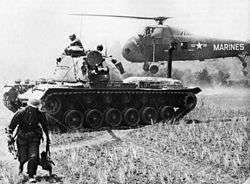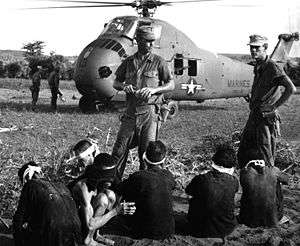Operation Starlite
Operation Starlite (also known in Vietnam as Battle of Van Tuong) was the first major offensive regimental size action conducted by a purely U.S. military unit during the Vietnam War. The operation was launched based on intelligence provided by Major General Nguyen Chanh Thi, the Army of the Republic of Vietnam (ARVN) commander in northern I Corps area. Lieutenant General Lewis W. Walt devised a plan to launch a pre-emptive strike against the Viet Cong (VC) 1st Regiment to nullify the threat on the vital Chu Lai Air Base and Base Area and ensure its powerful communication tower remained intact.
The operation was conducted as a combined arms assault involving ground, air and naval units. U.S. Marines were deployed by helicopter insertion into the designated landing zone while an amphibious landing was used to deploy other Marines.
Background
The operation was originally called Satellite, but a power blackout led to a clerical error and a clerk working by candlelight typed "Starlite" instead.[3] It was launched on D-Day August 18, 1965, involving 5,500 Marines. Regimental 2nd Battalion, 4th Marines (2/4), 1st Battalion, 7th Marines (1/7) and 3rd Battalion, 3rd Marines (3/3), and 3rd Battalion, 7th Marines (3/7) the SLF - permission was granted by Admiral Sharp to use Special Landing Force and originally a reserve component - in an assault on the VC base near Van Tuong. The United States Navy's USS Galveston and USS Cabildo were available for naval gunfire support and 3rd Battalion, 12th Marines was the artillery unit in direct support. USS Vernon County embarked elements of 3/3 Marines (Battalion Landing Team) (BLT) 3, under Lieutenant Colonel Joseph E. Muir, at Chu Lai, and sailed south along the coast to An Thuong, where she put the troops ashore in one phase of Starlite.
VC forces comprised the 1st VC Regiment made up of the 60th and 80th VC Battalions, the 52nd Company, and a company of the 45th Weapons Battalion. Total VC strength was around 1,500 men, and backed by several elite mortar units.
Battle

Company M, 3/3 Marines was designated the blocking force and deployed on 18 August 1965 using LVTP-5s to the operational area. When it landed on the beach, it marched 4 miles (6.5 km) to establish their blocking positions. 3/3 Marines made an amphibious landing and were tasked with driving the VC towards the 2/4 Marines who were to be lifted by helicopter into three landing zones west of Van Tuong. Secrecy was paramount, and no ARVN commander or units were informed of the impending operation.
The Marines met light resistance moving into the attack, using their M14 semi-automatic rifles to repulse occasional VC raiders. Company E, 2/4 Marines spotted VC in the open and called in artillery fire from 3/12th Marines. The artillery barrage was reported to have killed 90 VC, including crippling several of their mortar units. Company H, 2/4 Marines assaulted the VC 60th Battalion who put up a vicious fight, only being overwhelmed when helicopter gunships swooped on their position, peppering it with rocket and machine gun fire. One prisoner was taken and 40 weapons were captured. Company I, 3/3 Marines attacked An Cuong after receiving heavy fire from the hamlet and losing their company commander in the engagement.
On 21 August, a Marine armoured supply column became lost in a field, and was subsequently ambushed by VC. Two M48A3 tanks and four LVTP-5 were disabled by the time reinforcements arrived. Estimated casualties were 5 killed and 11 wounded out of 27 who were part of the convoy. This event was covered by journalist Peter Arnett and proved an embarrassment to the LBJ administration, who wanted to retain a secrecy of the operation.[4]
Company I was ordered to join Companies H and K and clean up any opposition, but was caught in a crossfire from Nam Yen Dan Hill 30. Company H established a defensive perimeter and were told to await reinforcements. The expected reinforcements, were diverted to assist the supply column that was ambushed west of their position. 37mm recoilless rifle fire from the VC positions tore into the 5 LVTs and 3 flame tanks, forcing the Marines to mount a rescue. The Marines were hit by intense mortar and rifle fire and suffered 5 dead and 17 wounded. They called in artillery and air support to suppress the mortar and automatic fire, F-4 fighter-bombers dropping cluster bombs, resulting in an avalanche on the hillside which wiped out many of the attacking rifle and mortar squads.
The developing engagement necessitated the deployment of Company L, 3/7 Marines from the USS Iwo Jima to join Company I to assist the ambushed supply column. Part of Company L was caught in a horseshoe ambush in their attempt to rescue the LVT personnel, 4 Marines were killed and 10 wounded. Come nightfall, the Marines hunkered down into defensive positions. Scout units of 3/7 Marines came ashore during the night and the battalion got ready for a morning assault on the Vietnamese positions. When they finally attacked they found the VC unit had already retreated from the encirclement during the night, though pockets of resistance continued from other VC fighters holed up in bunkers and caves. Fighting ceased at nightfall.
Aftermath
The Marines sustained 45 killed and 203 wounded.[5] US forces claimed killing 614 VC, capturing prisoners and 42 suspected guerillas. Corporal Robert E. O'Malley (3/3 Marines) and Lance Corporal Joe C. Paul (2/4 Marines) received the Medal of Honor for their actions during the operation. First Lieutenant Richard Purnell (3/3 Marines) received the Silver Star for conspicuous gallantry and intrepidity in action who assumed command in the battlefield when his commanding officer was killed by a grenade.[6] To the Americans, the battle was considered a great success for U.S. forces as they engaged a local force VC unit and came out victorious. The Vietcong Battalion also claimed victory, announcing that they had inflicted 900 American casualties (killed and wounded), destroyed 22 tanks and APCs, and downed 13 helicopters, while suffering 200-300 casualties before withdrawing.[7]
The story of the ambush of the Marine supply column was denied by the USMC.[4]
Lessons learned from the battle include the knowledge that the daily allotment of 2 gallons of water per man was inadequate in the heat of Vietnam and that the M14 Rifle was too bulky for troops crammed into small armored personnel carriers (APCs).
References
![]()
- ↑ Wilkins, Warren (2011). Grab Their Belts To Fight Them: The Viet Cong's Big-Unit War Against the U.S., 1965–1966. Annapolis: Naval Institute Press. p. 76. ISBN 9781591149613.
- ↑ http://www.quangngai.gov.vn/quangngai/tiengviet/bangtin/2004/1847/ Lieutenant General Nguyen Chon, Van Tuong battle
- ↑ Operation Starlite
- 1 2 "The Death of Supply Column 21". Columbia Journalism Review. Retrieved 2018-06-13.
- ↑ Shulimson, Jack (1978). U.S. Marines in Vietnam: The Landing and the Buildup. History and Museums Division, Headquarters, U.S. Marine Corps. p. 80. ISBN 978-1494287559.
- ↑ Richard Purnell, , "Military Times", August 18, 1965
- ↑ Nguyen Ngoc Toan, "Van Tuong victory raises confidence in defeating US troops", People's Army Newspaper, 21 December 2014.
Bibliography
- Lehrack, Otto (2004). The First Battle - Operation Starlite and the Beginning of the Blood Debt in Vietnam. Havertown, Pennsylvania: Casemate. ISBN 1-932033-27-0.
- Rod, Andrew (2015). The First Fight: U.S. Marines in Operation Starlite, August 1965. Quantico, VA: Marine Corps University, History Division. Retrieved 1 November 2015.
- Simmons, Edwin H. (2003). The United States Marines: A History, Fourth Edition. Annapolis, Maryland: Naval Institute Press. ISBN 1-59114-790-5.
- Summers, Harry G. Historical Atlas of the Vietnam War. New York: Houghton Mifflin Company.
